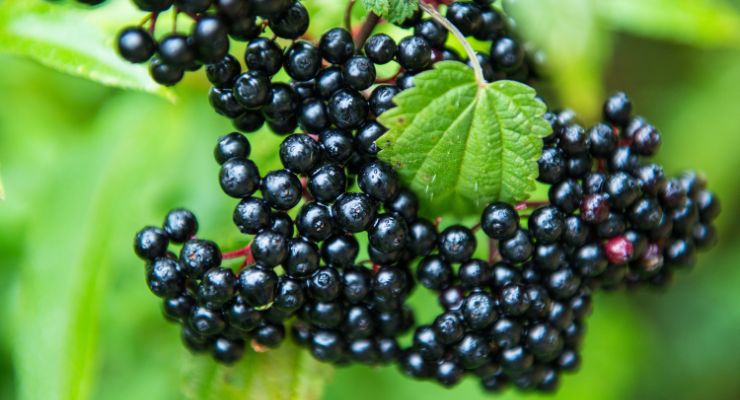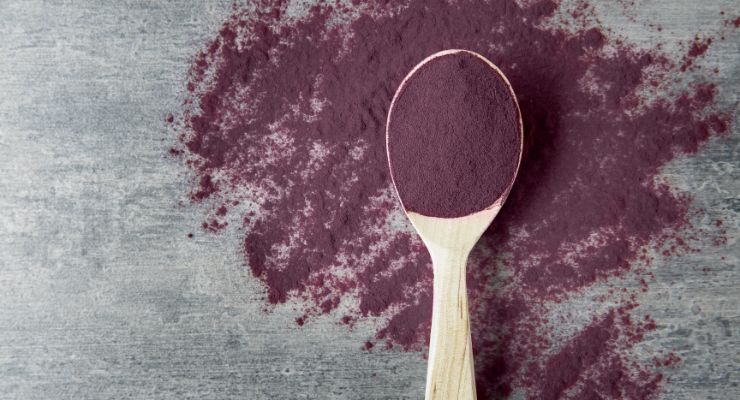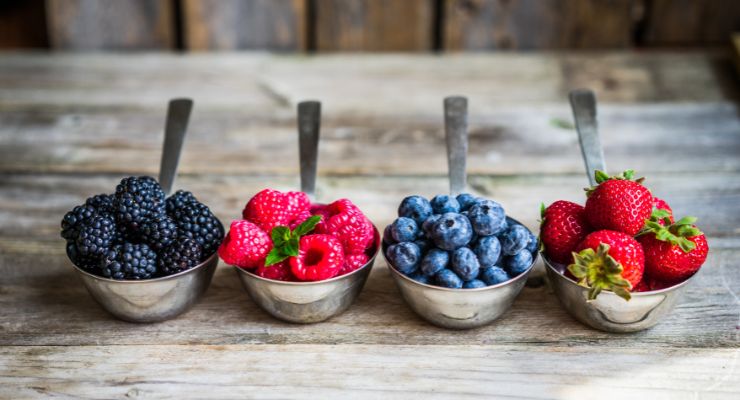By Melanie Bush, VP of Science and Research, Artemis International02.23.23
Plant-based is all the rage these days for reasons ranging from health to environmental concerns. And while the number of plant-based products on the market is vast and varied, few are more adaptable—or boast a more compelling narrative—than berries.
Thanks to effective marketing campaigns over the years, berries are now essentially synonymous with antioxidant power and therefore universally regarded as good for us. Healthwise, their stellar reputation is justified by decades of modern science. Desirable flavor profiles, bold colors, and mainstream acceptance significantly up the ante on berries. The bottom line? Berry ingredients are a perfect fit for a wide variety of functional food/beverage and dietary supplement applications.
In recent years, berry ingredient options have become much more sophisticated and diverse. There are so many more ways to reap the benefits of berries beyond sprinkling some on your cereal or taking a fruit supplement. Berry ingredients—specifically those with standardized bioactives—have grown in popularity within the supplement market and cover a wide array of health angles. But perhaps the largest growth opportunity lies with the evolving functional food and beverage market.

For example, elderberry has been studied for its immune health benefits as well as its prebiotic effects that support a healthier gut. Other studies show black currant extract can support vision amid excess screen use, a fact of life for most of us given how many of a typical adult’s waking hours (about 7 hours per day) are spent on devices. Eye strain and ways to remediate it are also a major concern within the rapidly growing esports community.
Berries like aronia berry can impact clinically relevant outcomes in the area of cardiovascular support and can do so without the side effects of common statins, which could benefit many consumers. In fact, there is an entire biannual Berry Health Benefits Symposium dedicated to sharing the latest research and findings on the health benefits berries offer humans.
The diverse health benefits of berries make it easy for product developers to formulate for functionality. The supplement industry has been doing this for some time with great success as the demand for berry ingredients continues to rise. But a growing trend is adding functionality to everyday foods and beverages beyond simply nutritional content.
The key lies in the unique phytonutrient (also known as phytochemical) profiles of berries that contain important bioactive compounds. Adding this phytonutrient content from berries can deliver health benefits beyond what just macros and micros can do in foods and beverages. For example, a high-protein snack bar could be enriched with an elderberry extract to add a punch of immune support as well—especially desirable in today’s world, for obvious reasons.
Plus, the future is now in terms of dietary guidelines for phytonutrients, as evidenced by the adoption of a recommended dietary intake for a class of plant phytochemicals called flavan-3-ols. Ultimately, adding berry functionality can help differentiate products, as well as level them up with additional proven benefits spanning multiple angles of health—a win-win for brands and consumers alike.
Supplement delivery options have diversified over the years. Initially, capsules and tablets reigned supreme. Now, the mix of options also includes gummies, liquids, lozenges, sachets and stick packs, and more. Similarly, the studied health benefits of specialty berry ingredients can elevate existing food and beverage choices and make room for innovative functional products that savvy consumers crave.
Imagine a decadent square of dark chocolate as the means of consuming an elderberry extract shown in studies to reduce the duration of colds/flu. Or cookies enriched with a berry blend full of phytonutrients to level up an otherwise purely indulgent treat. Or an energy drink that uses the power of a studied black currant extract to help relieve the screen-weary eyes of esports players and fans. Or even an orange juice with added elderberry for extra immune support on top of the usual vitamin C. The possibilities are endless.
As consumers increasingly look toward their dietary choices as a path to wellness, the line between supplementation and diet begins to blur. There will still always be a place for dedicated supplements, but if food products can be made healthier by way of enhanced functionality, more consumers can benefit.
Another growth trend that spans both supplements and functional foods lies in multi-functional products or blends that can provide consumers with more bang for their buck. Between inflation and supplement fatigue, consumers are ready to consolidate purchases where possible. Some multi-functional blends just make sense in today’s world—for example, an immune support formula that also addresses key post-pandemic concerns like cardiovascular health and vision health in a single product. Or using the dual functionality of an ingredient like European black elderberry to create a combination immune health and gut support beverage.

Need a natural vitamin C? Try an acerola cherry extract. Want to deliver a particular level of protein or fiber from a fruit source? Certain standardized cranberry ingredients fit that bill. Ready to add some of those polyphenols you keep reading about to your healthy beverage formulation? Food-grade, soluble berry extracts that are standardized to polyphenols are the perfect solution. Soluble options, standardization options for consistent usage rates of bioactives, GRAS options, and shelf-stable options offer myriad opportunities for using berries in innovative new ways.
Due to the large variety of options and preparations, berries are a formulator’s dream. In fact, for quite some time berry ingredients have been widely used as flavors and natural colorants. Many have a sweet or tart flavor profile, and those that are more astringent can often be masked with the right ingredient blend of sweetener. It’s worth noting that the color impact can be significant. While that can eliminate the need for any colorants, artificial or otherwise, formulators should note that consumers could perceive an odd disconnect if, for instance, a deep, purple-colored beverage is formulated to have a lemon-lime flavor.
Another caution to formulators is that since there are numerous types of berry ingredients, they need to be aware which would be the most appropriate for a particular formula and any desired benefits. For example, standardized extracts and juice powders are not the same thing, and one is much more concentrated in certain bioactives. Also, some processing conditions like prolonged heat can start to degrade certain polyphenol actives. Therefore, adding berry ingredients in the later stages of batch production could be advantageous to minimize losses. Experienced berry ingredient suppliers can assist throughout R&D phases to help their customers develop best-in-class products.

Consumers perceive berry ingredients listed on a nutrition facts or supplement facts label positively, since they already have an association with wellness. The time is ripe to incorporate the additional functionality of berries into new product concepts and to utilize crossover ingredients in foods and beverages that have already garnered quite a following within the supplement market.
When sourcing berry ingredients, it’s essential to do your research, verify the supply line and work only with reputable suppliers willing to share data transparently and provide thorough answers to questions. Do your due diligence to ensure you are choosing the right type of berry ingredient for your desired purpose and at a usage rate that is meaningful.
Now more than ever, there are endless opportunities to harness the power of berries to create better-for-you foods, beverages, and supplements.
 About the Author: Melanie Bush is vice president of science and research at Artemis International. With more than 15 years of experience at the company, her responsibilities span several departments including quality assurance, R&D, and technical sales support. She enjoys spearheading new research in the field of dark berry extracts and communicating the ever-evolving science of berry phytonutrients.
About the Author: Melanie Bush is vice president of science and research at Artemis International. With more than 15 years of experience at the company, her responsibilities span several departments including quality assurance, R&D, and technical sales support. She enjoys spearheading new research in the field of dark berry extracts and communicating the ever-evolving science of berry phytonutrients.
Thanks to effective marketing campaigns over the years, berries are now essentially synonymous with antioxidant power and therefore universally regarded as good for us. Healthwise, their stellar reputation is justified by decades of modern science. Desirable flavor profiles, bold colors, and mainstream acceptance significantly up the ante on berries. The bottom line? Berry ingredients are a perfect fit for a wide variety of functional food/beverage and dietary supplement applications.
In recent years, berry ingredient options have become much more sophisticated and diverse. There are so many more ways to reap the benefits of berries beyond sprinkling some on your cereal or taking a fruit supplement. Berry ingredients—specifically those with standardized bioactives—have grown in popularity within the supplement market and cover a wide array of health angles. But perhaps the largest growth opportunity lies with the evolving functional food and beverage market.

Formulating for Functionality
Historically, the main health benefit ascribed to berries as a general category has been their antioxidant capacity and related overall wellness attributes. But more recently, thanks to research advances, we know much more about specific areas of health that particular berries can benefit.For example, elderberry has been studied for its immune health benefits as well as its prebiotic effects that support a healthier gut. Other studies show black currant extract can support vision amid excess screen use, a fact of life for most of us given how many of a typical adult’s waking hours (about 7 hours per day) are spent on devices. Eye strain and ways to remediate it are also a major concern within the rapidly growing esports community.
Berries like aronia berry can impact clinically relevant outcomes in the area of cardiovascular support and can do so without the side effects of common statins, which could benefit many consumers. In fact, there is an entire biannual Berry Health Benefits Symposium dedicated to sharing the latest research and findings on the health benefits berries offer humans.
The diverse health benefits of berries make it easy for product developers to formulate for functionality. The supplement industry has been doing this for some time with great success as the demand for berry ingredients continues to rise. But a growing trend is adding functionality to everyday foods and beverages beyond simply nutritional content.
The key lies in the unique phytonutrient (also known as phytochemical) profiles of berries that contain important bioactive compounds. Adding this phytonutrient content from berries can deliver health benefits beyond what just macros and micros can do in foods and beverages. For example, a high-protein snack bar could be enriched with an elderberry extract to add a punch of immune support as well—especially desirable in today’s world, for obvious reasons.
Plus, the future is now in terms of dietary guidelines for phytonutrients, as evidenced by the adoption of a recommended dietary intake for a class of plant phytochemicals called flavan-3-ols. Ultimately, adding berry functionality can help differentiate products, as well as level them up with additional proven benefits spanning multiple angles of health—a win-win for brands and consumers alike.
'As consumers increasingly look toward their dietary choices as a path to wellness, the line between supplementation and diet begins to blur. There will still always be a place for dedicated supplements, but if food products can be made healthier by way of enhanced functionality, more consumers can benefit.'
Applications Abound
As the science behind berries and their health benefits has advanced, so too have the potential applications and delivery systems for adding this functionality. Consumers are seeking more creative and palate-pleasing ways to supplement their diets with ingredients that convey added health benefits. In a similar vein, pet food offers a huge market opportunity.Supplement delivery options have diversified over the years. Initially, capsules and tablets reigned supreme. Now, the mix of options also includes gummies, liquids, lozenges, sachets and stick packs, and more. Similarly, the studied health benefits of specialty berry ingredients can elevate existing food and beverage choices and make room for innovative functional products that savvy consumers crave.
Imagine a decadent square of dark chocolate as the means of consuming an elderberry extract shown in studies to reduce the duration of colds/flu. Or cookies enriched with a berry blend full of phytonutrients to level up an otherwise purely indulgent treat. Or an energy drink that uses the power of a studied black currant extract to help relieve the screen-weary eyes of esports players and fans. Or even an orange juice with added elderberry for extra immune support on top of the usual vitamin C. The possibilities are endless.
As consumers increasingly look toward their dietary choices as a path to wellness, the line between supplementation and diet begins to blur. There will still always be a place for dedicated supplements, but if food products can be made healthier by way of enhanced functionality, more consumers can benefit.
Another growth trend that spans both supplements and functional foods lies in multi-functional products or blends that can provide consumers with more bang for their buck. Between inflation and supplement fatigue, consumers are ready to consolidate purchases where possible. Some multi-functional blends just make sense in today’s world—for example, an immune support formula that also addresses key post-pandemic concerns like cardiovascular health and vision health in a single product. Or using the dual functionality of an ingredient like European black elderberry to create a combination immune health and gut support beverage.

Inviting Innovation
The berry category is broad, and as such, there is a vast range of berry-based ingredient forms. Options include soluble juice powders, standardized extracts, pre-blends, liquid concentrates, insoluble fiber products, and seed oil powders. Each one can fill a particular need.Need a natural vitamin C? Try an acerola cherry extract. Want to deliver a particular level of protein or fiber from a fruit source? Certain standardized cranberry ingredients fit that bill. Ready to add some of those polyphenols you keep reading about to your healthy beverage formulation? Food-grade, soluble berry extracts that are standardized to polyphenols are the perfect solution. Soluble options, standardization options for consistent usage rates of bioactives, GRAS options, and shelf-stable options offer myriad opportunities for using berries in innovative new ways.
Due to the large variety of options and preparations, berries are a formulator’s dream. In fact, for quite some time berry ingredients have been widely used as flavors and natural colorants. Many have a sweet or tart flavor profile, and those that are more astringent can often be masked with the right ingredient blend of sweetener. It’s worth noting that the color impact can be significant. While that can eliminate the need for any colorants, artificial or otherwise, formulators should note that consumers could perceive an odd disconnect if, for instance, a deep, purple-colored beverage is formulated to have a lemon-lime flavor.
Another caution to formulators is that since there are numerous types of berry ingredients, they need to be aware which would be the most appropriate for a particular formula and any desired benefits. For example, standardized extracts and juice powders are not the same thing, and one is much more concentrated in certain bioactives. Also, some processing conditions like prolonged heat can start to degrade certain polyphenol actives. Therefore, adding berry ingredients in the later stages of batch production could be advantageous to minimize losses. Experienced berry ingredient suppliers can assist throughout R&D phases to help their customers develop best-in-class products.

Better with Berries
Hands down, eating fresh berries is a health win. But consumers still aren’t getting enough of them, and there are particular berries that don’t grow locally or aren’t palatable in fresh form, that carry tremendous health benefits. That’s where formulating with the plethora of available berry ingredients comes in.Consumers perceive berry ingredients listed on a nutrition facts or supplement facts label positively, since they already have an association with wellness. The time is ripe to incorporate the additional functionality of berries into new product concepts and to utilize crossover ingredients in foods and beverages that have already garnered quite a following within the supplement market.
When sourcing berry ingredients, it’s essential to do your research, verify the supply line and work only with reputable suppliers willing to share data transparently and provide thorough answers to questions. Do your due diligence to ensure you are choosing the right type of berry ingredient for your desired purpose and at a usage rate that is meaningful.
Now more than ever, there are endless opportunities to harness the power of berries to create better-for-you foods, beverages, and supplements.





























